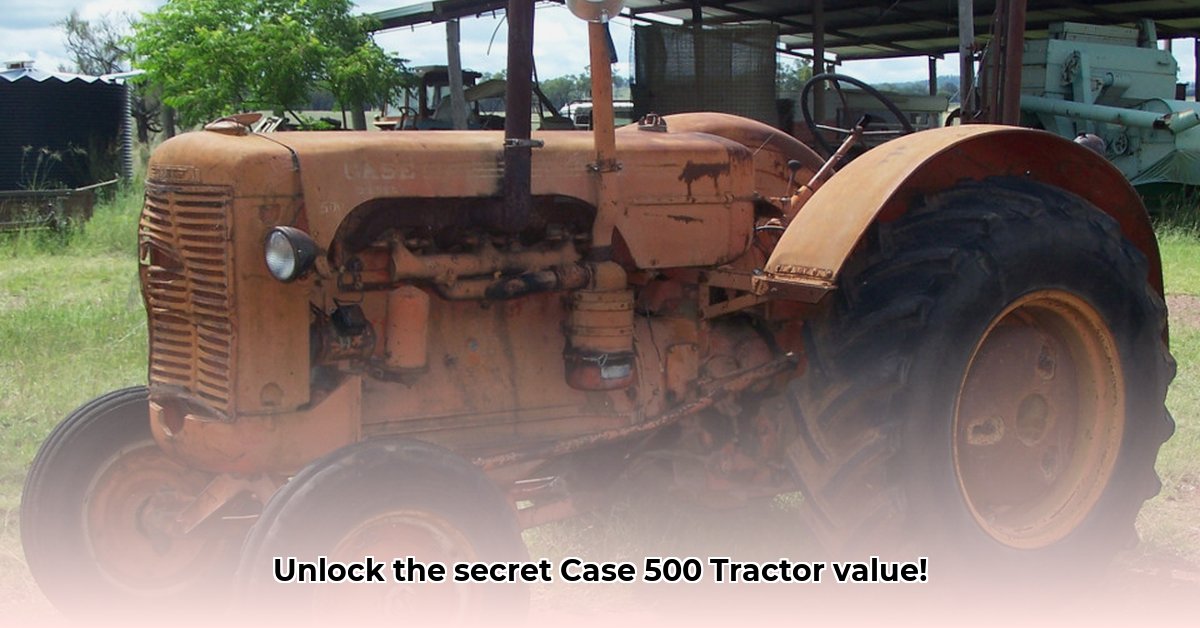
The J.I. Case 500 tractor, produced from 1953 to 1957, represents a significant piece of agricultural history. With only around 6,000 units manufactured, finding a Case 500 is a rare opportunity for collectors and enthusiasts. This guide provides a comprehensive overview of factors influencing the value of a Case 500, assisting both buyers and sellers in navigating this niche market. For more Case tractor information, see this helpful resource: Case Tractor Info.
What Influences a Case 500's Value?
The value of a Case 500 tractor varies significantly, depending on several key factors. Think of it like a classic car; condition and completeness are paramount. A fully restored tractor in pristine condition will command a much higher price than one requiring significant restoration.
Condition: The Cornerstone of Value
A meticulous assessment of the tractor's condition is vital. This involves a thorough examination of both its cosmetic and mechanical aspects.
Cosmetic Condition:
- Excellent: Minimal wear, original paint (or expertly restored), intact decals, and gleaming chrome. These represent highly collectible machines.
- Good: Minor wear, possible repainting or touch-ups, but overall presentable.
- Fair: Noticeable wear, paint damage, rust, and missing components. The tractor might function but requires attention.
- Poor: Significant rust, mechanical issues, and missing major components. Substantial restoration is needed.
Mechanical Condition:
- Fully Operational: The engine runs smoothly, and all systems function correctly, a crucial factor for higher valuations.
- Needs Repair: Minor issues easily rectified yet still impacting overall value.
- Major Repairs Needed: Significant mechanical problems requiring substantial investment, substantially lowering the tractor's worth. This might include engine overhaul or transmission rebuild.
Completeness and Authenticity
A Case 500 with all original parts, the owner's manual, and even its original tools is a highly desirable find. Missing components significantly decrease its value. Authenticity is equally crucial. A documented history—knowing its previous owners and maintenance records—adds to its value and desirability. This verifiable history enhances trust and assures potential buyers.
Market Trends and Rarity
The Case 500 market exhibits considerable price variation, ranging from a few hundred dollars to several thousand. This underscores the importance of considering condition, completeness, and historical documentation. A fully restored and well-documented Case 500 is a rare commodity. Remember that restoration is costly and time-consuming.
Did you know that the Case 520, the industrial counterpart of the Case 500, is even rarer, with only about 265 units produced? This scarcity makes the Case 520 a particularly sought-after item among industrial equipment collectors.
Buying or Selling Your Case 500: A Practical Guide
This section provides a step-by-step approach for both buyers and sellers.
For Buyers:
- Thorough Research: Investigate the Case 500's history, specifications, and market trends.
- Expert Inspection: Engage a knowledgeable mechanic for a pre-purchase inspection. This is a non-negotiable step to avoid costly surprises.
- Verify Authenticity: Confirm the tractor's history is accurate and legitimate.
- Strategic Negotiation: Leverage your research and inspection findings to negotiate a fair price.
For Sellers:
- Honest Assessment: Accurately evaluate your Case 500's condition and be transparent about any imperfections.
- Document Its History: Gather and document as much historical data as possible.
- High-Quality Presentation: Capture excellent photographs showcasing the tractor's features.
- Targeted Marketing: Select the most appropriate platform(s) to reach potential buyers within the vintage tractor collector community.
Accurately Assessing Value: A Step-by-Step Approach
- Meticulous Documentation: Take detailed photos and videos of all aspects of the tractor, including the serial number and any unique components.
- Market Research: Examine online marketplaces, auction results (while keeping in mind variability in transaction costs), and consult local collector networks for comparable Case 500 models.
- Expert Appraisal: Consider obtaining a formal appraisal from a vintage tractor specialist or appraiser for an objective valuation, particularly advantageous for large transactions.
- Regional Considerations: Prices vary regionally due to differences in demand and transportation costs.
- Restoration Cost Analysis: If undertaking restoration, factor in the costs of parts, labor, and expertise. This directly impacts the final value.
The Case 500's Enduring Legacy
The rarity and durable reputation of the Case 500 suggest its value will likely appreciate among collectors. However, market dynamics shift, so staying informed about current trends is vital. Whether restoring a classic or working on a project, owning a Case 500 offers a rewarding experience for enthusiasts of vintage farm machinery. Further research into production records and the impact of restoration quality on resale value is ongoing. The information provided here is current but subject to revision based on future analysis.
Key Takeaways:
- The Case 500 market, while vibrant, lacks standardized pricing.
- Condition is paramount: a restored Case 500 is substantially more valuable than a neglected one.
- Rarity significantly impacts value: unique features or model variations command higher prices.
- Online resources provide a general guide but are not always reflective of real-world transactions.
- Location influences price, reflecting regional demand and transportation costs.